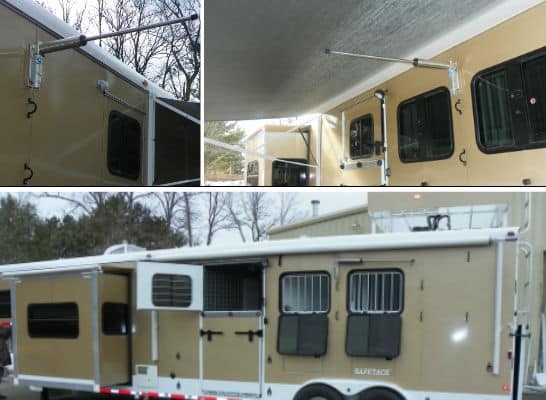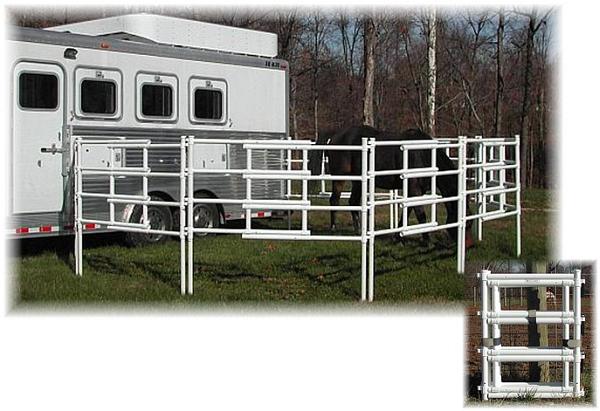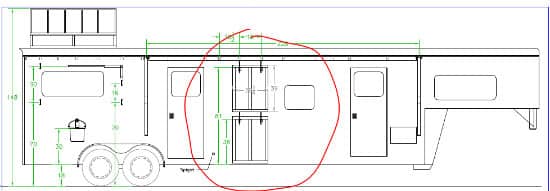Trailer Exteriors Are NOT 'Horse Proof': Tying Alternatives to Protect Your Horse and Trailer
The outside of a horse trailer is not the safest place for a horse. Wait…what?! Yes, you read that correctly. No matter how carefully manufacturers design their trailers, potential will exist for horses to injure themselves while tied. Think about it…tires, fenders, door latches, the hitch, awnings, dressing room doors, and electrical components are all necessary for your trailer to function. However, they are not ideal for curious horses that act like horses do…complete with pawing, head tossing, chewing, and occasional bouts of panic when loud noises cause them to spook.
At Double D Trailers, we do everything possible to horse proof the exterior, but there will remain, as with other manufacturers, uncontrollable safety hazards that can injure your horse. There is also the real potential that your horse may damage the trailer! That’s why we’ve put together this article on a few alternatives to use next time you need to secure your horse near the trailer.
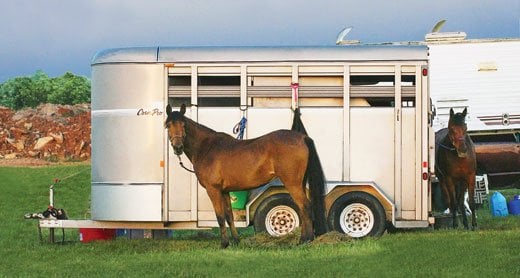
Potential For Damage To Your Horse AND To Your Trailer
Double D Trailers owner Brad Heath shared his take on the potential hazards of tying to a horse trailer. He explained, “Horse trailers are designed to be ‘horse safe’ on the inside, but not so much on the ‘outside.’”
He continued, “As a manufacturer, it's difficult to design a trailers so that doors swing in the correct direction, awnings open properly, and windows drop down without interfering with horse ties. We also need to account for outside spigots, electrical receptacles, spare tire mount, and endless other features.”
Brad explained that in addition to potential injury to your horse, tying to a horse trailer doesn’t exactly make financial sense. Horse trailers can be expensive and your horse is very capable of damaging the exterior by breaking the fender lights, damaging doors, scratching the paint, putting dents in the side, or even damaging the tires. Horses are curious by nature and they are bound to interact with the trailer either intentionally or accidentally while tied.
Brad chuckled, “It's like purchasing a new vehicle, parking it in the garage, and watching my four year old ride her bike around it hoping she isn't going to damage the auto - you know it's going to happen!”
What’s So Dangerous About Tying My Horse Outside the Trailer?
Let’s look at a specific example of how tying to the outside of a trailer can either endanger the horse or endanger the trailer.
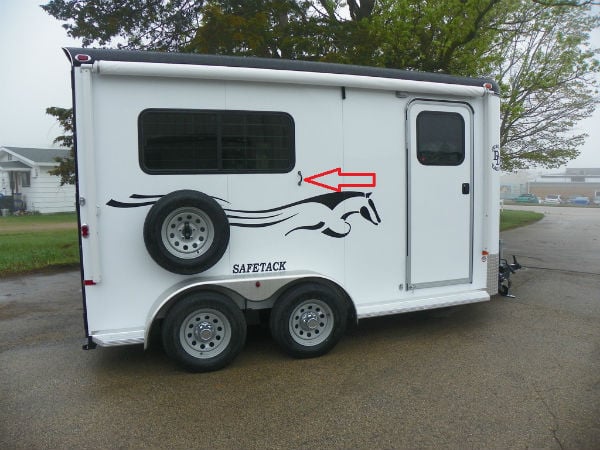
Still, there are several potential hazards with the tie loop location …
First, the dressing room door was required to swing towards the rear rather than the usual direction of towards the front. This change was made so that when the awning is rolled out, the door doesn’t swing out and hit the support, which would have damaged either the door or the awning.
Brad explained, “When a horse is tied in the location, and the dress door is opened, it's possible a horse could injure himself on the door or the door corner at the bottom. He could also get a rope or halter caught underneath the door corner.”
One possible way to avoid this issue would be to use a very short tie to reduce the risk of injury to your horse, but the horse could still accidentally bump the door while it’s open and severely damage the door, or at the very least, break the door tie back.
Ok, I’m sure you’re thinking: Just move the tie loop away from the door.
Brad shared, “If we move the tie loop back to the next structural upright, then the tie is too close to the spare and a horse could potentially get a rope caught underneath the tire.”
If the tie loop was relocated one more section towards the rear, then the horse would be standing in front of the mechanisms used to secure the back doors. “There are cam latches used to secure the door closes, door handles, door hold backs, etc,” Brad explained. “All of those are made as ‘horse safe’ as possible, but the possibility exist in the right circumstances for injury to occur, and/or damage to the trailer.
Are you starting to see the point?
This is just one trailer example but the list of potential injuries exists on almost every model from every manufacturer. Longer trailers can be a bit easier to work with since there is more space to locate tie loops.
It is most common for tie loops to be located in the vicinity of the tires and fenders. Even this has risk. “A horse can easily step on and rip a tire valve stem out causing the tire to virtually explode. While it may not cause direct injury, the extreme noise from the tire air escaping would surely spook a horse and we all are well aware of the capabilities of a panicked horse.”
I’m Convinced: What Are The Safer Alternatives To Regular Tying?
Now that we’ve looked at all of the big scary hazards, let’s take a look at a few alternatives that might save your horse and trailer from distress.
The first option is complete separation in a rental stall or paddock area. If a rental is available and affordable, it will save you from dealing with this issue altogether. If rentals are not available, you could also learn how to string a picket line between sturdy trees.
A more feasible option for many horseman-on-the-go would be a trailer tie mechanism that moves the horse farther away from the side of the trailer. Brad shared one example of a client who asked for a Tilt-Tie attachment on her new gooseneck horse trailer.
“We had a client that wanted her horse underneath the awning. When the tie is not in use, it lays flat against the trailer. When in use you can swing it around so that your horses isn't so close to the side of the trailer, reducing the risk of potential problem/injury spots for your horse.”
This type of set up is available under many brand names including Tilt-Tie, TieRite, and HiTie. Each of them gives the horse free movement away from the trailer where they can graze, eat, drink, and even lie down while being tied. They are away from the trailer so less likely to injure themselves or damage the trailer while tied.
Brad has been pleased with his clients’ response. “We have several customers using such devices as these and so far the feedback has been positive. There is reduced damage to trailers and reduced injury to horses.”
Another option for people who want to add a bit of separation between their horses and trailer would be to pack along a portable corral. Some portable corral brands can be heavy, bulky, and difficult to mount, however Brad recommends one brand of collapsible corral panels that are made of PVC.
Photo credit: Carri-Lite Corral
“I like how the panels collapse to minimize necessary space for hauling and of course expand to serve as a nice corral once you arrive.” The Carri-lite Corral panels can be mounted directly on the side of the trailer for transport and then set up away from the trailer upon arrival.
Brad recalled, “One of my clients installed these on her gooseneck horse trailer and I have been impressed with the versatility.” They are lightweight and telescoping to reduce the amount of space required for carrying.
Regardless of how you deal with the situation, it is important to acknowledge the hazards of tying your horse to the outside of a trailer. Keep an eye on them and consider one of the options listed here to distance them from the hazards. You may be saving your horse from injury and your trailer from expensive repairs. Happy travels!

